HI6028 Taxation Theory Practice & Law Individual Assignment T2 2017
VerifiedAdded on 2020/03/28
|9
|2542
|403
Homework Assignment
AI Summary
This document presents a comprehensive solution to a taxation assignment, HI6028 Taxation Theory, Practice & Law, from T2 2017. The assignment explores several key taxation issues through different scenarios. The first solution focuses on calculating net capital gains and losses, considering asset disposal and capital gains tax implications. The second solution delves into fringe benefits tax, specifically concerning a loan provided to an employee, calculating the taxable value based on statutory interest rates. The third solution examines the tax implications of a rental property owned by joint tenants, addressing profit and loss allocation. The fourth solution presents a case study on tax avoidance principles, referencing the Duke of Westminster case. Finally, the fifth solution analyzes the taxation of timber sales, differentiating between regular business operations and one-off disposals, and applying relevant tax provisions. The solutions provide detailed calculations, regulations, and applicability analyses, offering a complete understanding of the tax principles involved.
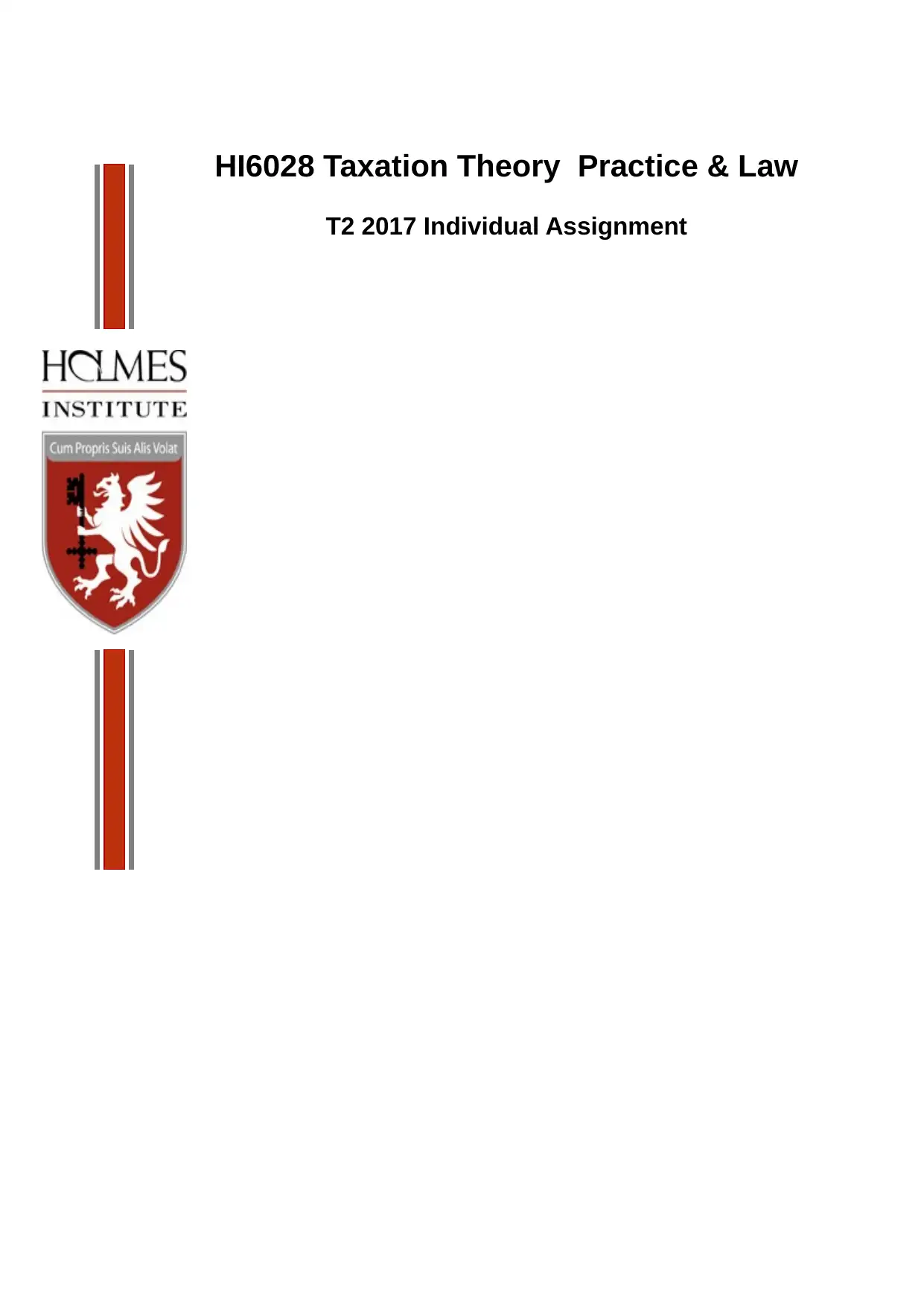
HI6028 Taxation Theory Practice & Law
T2 2017 Individual Assignment
T2 2017 Individual Assignment
Paraphrase This Document
Need a fresh take? Get an instant paraphrase of this document with our AI Paraphraser
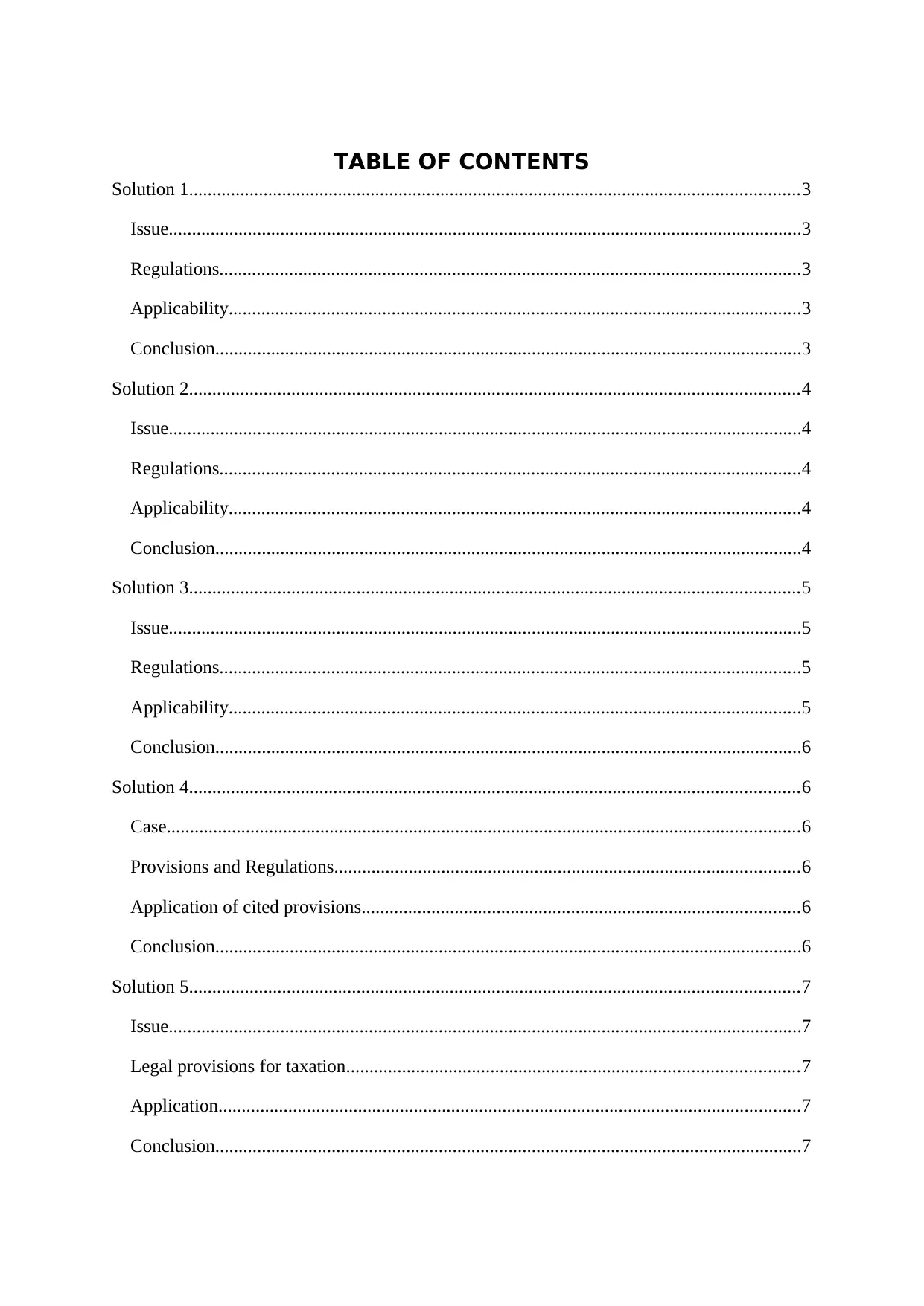
TABLE OF CONTENTS
Solution 1...................................................................................................................................3
Issue........................................................................................................................................3
Regulations.............................................................................................................................3
Applicability...........................................................................................................................3
Conclusion..............................................................................................................................3
Solution 2...................................................................................................................................4
Issue........................................................................................................................................4
Regulations.............................................................................................................................4
Applicability...........................................................................................................................4
Conclusion..............................................................................................................................4
Solution 3...................................................................................................................................5
Issue........................................................................................................................................5
Regulations.............................................................................................................................5
Applicability...........................................................................................................................5
Conclusion..............................................................................................................................6
Solution 4...................................................................................................................................6
Case........................................................................................................................................6
Provisions and Regulations....................................................................................................6
Application of cited provisions..............................................................................................6
Conclusion..............................................................................................................................6
Solution 5...................................................................................................................................7
Issue........................................................................................................................................7
Legal provisions for taxation.................................................................................................7
Application.............................................................................................................................7
Conclusion..............................................................................................................................7
Solution 1...................................................................................................................................3
Issue........................................................................................................................................3
Regulations.............................................................................................................................3
Applicability...........................................................................................................................3
Conclusion..............................................................................................................................3
Solution 2...................................................................................................................................4
Issue........................................................................................................................................4
Regulations.............................................................................................................................4
Applicability...........................................................................................................................4
Conclusion..............................................................................................................................4
Solution 3...................................................................................................................................5
Issue........................................................................................................................................5
Regulations.............................................................................................................................5
Applicability...........................................................................................................................5
Conclusion..............................................................................................................................6
Solution 4...................................................................................................................................6
Case........................................................................................................................................6
Provisions and Regulations....................................................................................................6
Application of cited provisions..............................................................................................6
Conclusion..............................................................................................................................6
Solution 5...................................................................................................................................7
Issue........................................................................................................................................7
Legal provisions for taxation.................................................................................................7
Application.............................................................................................................................7
Conclusion..............................................................................................................................7
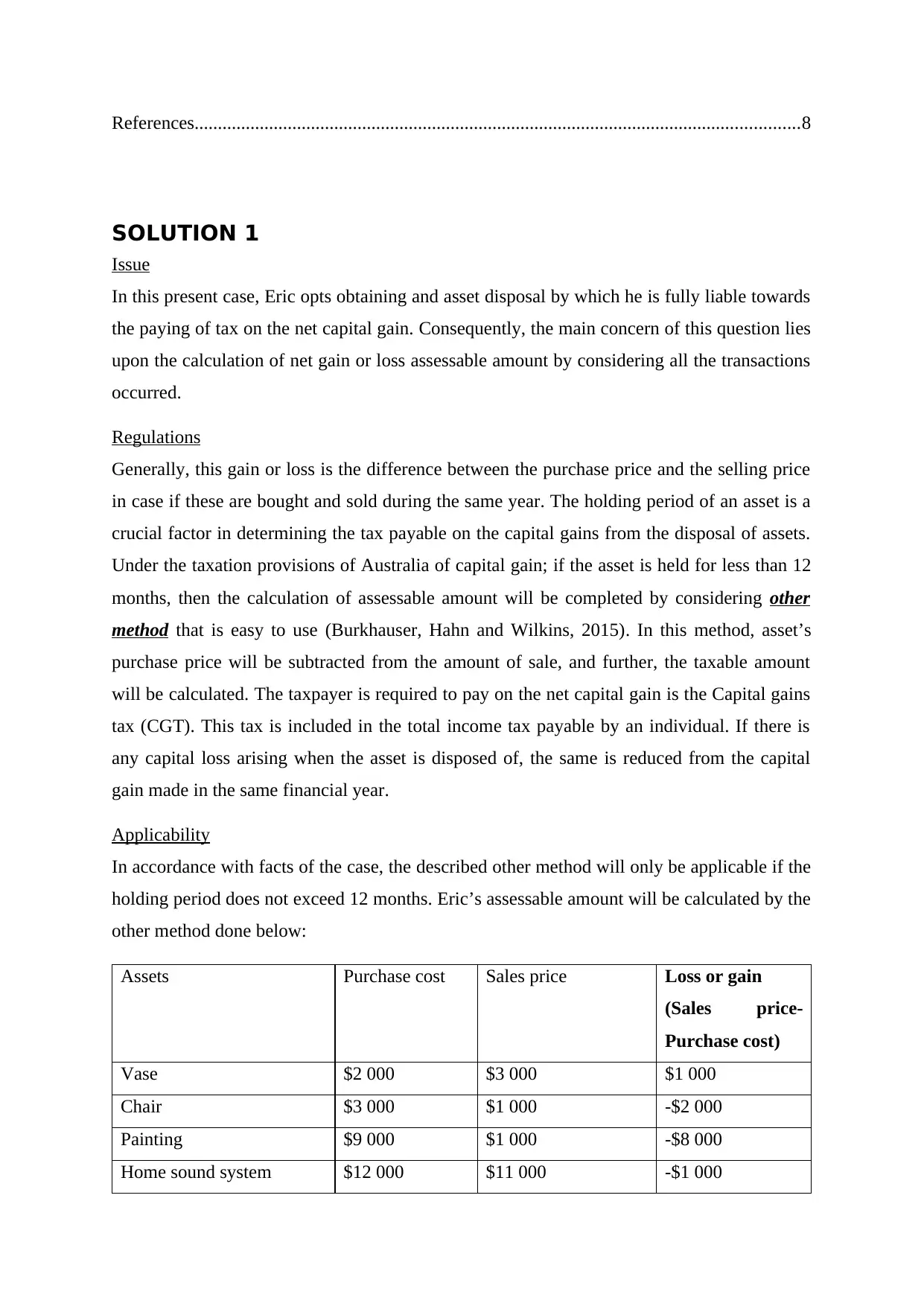
References..................................................................................................................................8
SOLUTION 1
Issue
In this present case, Eric opts obtaining and asset disposal by which he is fully liable towards
the paying of tax on the net capital gain. Consequently, the main concern of this question lies
upon the calculation of net gain or loss assessable amount by considering all the transactions
occurred.
Regulations
Generally, this gain or loss is the difference between the purchase price and the selling price
in case if these are bought and sold during the same year. The holding period of an asset is a
crucial factor in determining the tax payable on the capital gains from the disposal of assets.
Under the taxation provisions of Australia of capital gain; if the asset is held for less than 12
months, then the calculation of assessable amount will be completed by considering other
method that is easy to use (Burkhauser, Hahn and Wilkins, 2015). In this method, asset’s
purchase price will be subtracted from the amount of sale, and further, the taxable amount
will be calculated. The taxpayer is required to pay on the net capital gain is the Capital gains
tax (CGT). This tax is included in the total income tax payable by an individual. If there is
any capital loss arising when the asset is disposed of, the same is reduced from the capital
gain made in the same financial year.
Applicability
In accordance with facts of the case, the described other method will only be applicable if the
holding period does not exceed 12 months. Eric’s assessable amount will be calculated by the
other method done below:
Assets Purchase cost Sales price Loss or gain
(Sales price-
Purchase cost)
Vase $2 000 $3 000 $1 000
Chair $3 000 $1 000 -$2 000
Painting $9 000 $1 000 -$8 000
Home sound system $12 000 $11 000 -$1 000
SOLUTION 1
Issue
In this present case, Eric opts obtaining and asset disposal by which he is fully liable towards
the paying of tax on the net capital gain. Consequently, the main concern of this question lies
upon the calculation of net gain or loss assessable amount by considering all the transactions
occurred.
Regulations
Generally, this gain or loss is the difference between the purchase price and the selling price
in case if these are bought and sold during the same year. The holding period of an asset is a
crucial factor in determining the tax payable on the capital gains from the disposal of assets.
Under the taxation provisions of Australia of capital gain; if the asset is held for less than 12
months, then the calculation of assessable amount will be completed by considering other
method that is easy to use (Burkhauser, Hahn and Wilkins, 2015). In this method, asset’s
purchase price will be subtracted from the amount of sale, and further, the taxable amount
will be calculated. The taxpayer is required to pay on the net capital gain is the Capital gains
tax (CGT). This tax is included in the total income tax payable by an individual. If there is
any capital loss arising when the asset is disposed of, the same is reduced from the capital
gain made in the same financial year.
Applicability
In accordance with facts of the case, the described other method will only be applicable if the
holding period does not exceed 12 months. Eric’s assessable amount will be calculated by the
other method done below:
Assets Purchase cost Sales price Loss or gain
(Sales price-
Purchase cost)
Vase $2 000 $3 000 $1 000
Chair $3 000 $1 000 -$2 000
Painting $9 000 $1 000 -$8 000
Home sound system $12 000 $11 000 -$1 000
⊘ This is a preview!⊘
Do you want full access?
Subscribe today to unlock all pages.

Trusted by 1+ million students worldwide
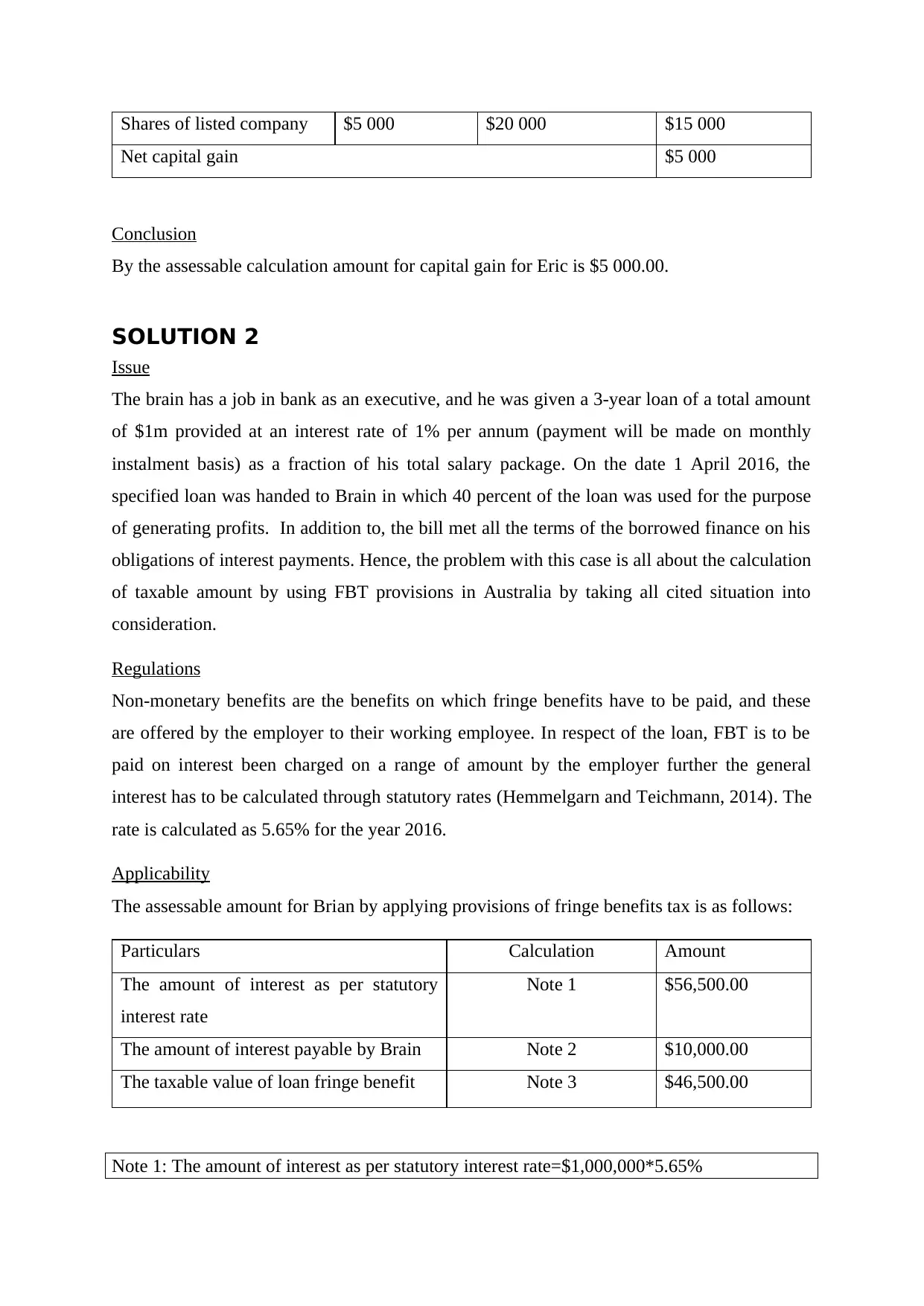
Shares of listed company $5 000 $20 000 $15 000
Net capital gain $5 000
Conclusion
By the assessable calculation amount for capital gain for Eric is $5 000.00.
SOLUTION 2
Issue
The brain has a job in bank as an executive, and he was given a 3-year loan of a total amount
of $1m provided at an interest rate of 1% per annum (payment will be made on monthly
instalment basis) as a fraction of his total salary package. On the date 1 April 2016, the
specified loan was handed to Brain in which 40 percent of the loan was used for the purpose
of generating profits. In addition to, the bill met all the terms of the borrowed finance on his
obligations of interest payments. Hence, the problem with this case is all about the calculation
of taxable amount by using FBT provisions in Australia by taking all cited situation into
consideration.
Regulations
Non-monetary benefits are the benefits on which fringe benefits have to be paid, and these
are offered by the employer to their working employee. In respect of the loan, FBT is to be
paid on interest been charged on a range of amount by the employer further the general
interest has to be calculated through statutory rates (Hemmelgarn and Teichmann, 2014). The
rate is calculated as 5.65% for the year 2016.
Applicability
The assessable amount for Brian by applying provisions of fringe benefits tax is as follows:
Particulars Calculation Amount
The amount of interest as per statutory
interest rate
Note 1 $56,500.00
The amount of interest payable by Brain Note 2 $10,000.00
The taxable value of loan fringe benefit Note 3 $46,500.00
Note 1: The amount of interest as per statutory interest rate=$1,000,000*5.65%
Net capital gain $5 000
Conclusion
By the assessable calculation amount for capital gain for Eric is $5 000.00.
SOLUTION 2
Issue
The brain has a job in bank as an executive, and he was given a 3-year loan of a total amount
of $1m provided at an interest rate of 1% per annum (payment will be made on monthly
instalment basis) as a fraction of his total salary package. On the date 1 April 2016, the
specified loan was handed to Brain in which 40 percent of the loan was used for the purpose
of generating profits. In addition to, the bill met all the terms of the borrowed finance on his
obligations of interest payments. Hence, the problem with this case is all about the calculation
of taxable amount by using FBT provisions in Australia by taking all cited situation into
consideration.
Regulations
Non-monetary benefits are the benefits on which fringe benefits have to be paid, and these
are offered by the employer to their working employee. In respect of the loan, FBT is to be
paid on interest been charged on a range of amount by the employer further the general
interest has to be calculated through statutory rates (Hemmelgarn and Teichmann, 2014). The
rate is calculated as 5.65% for the year 2016.
Applicability
The assessable amount for Brian by applying provisions of fringe benefits tax is as follows:
Particulars Calculation Amount
The amount of interest as per statutory
interest rate
Note 1 $56,500.00
The amount of interest payable by Brain Note 2 $10,000.00
The taxable value of loan fringe benefit Note 3 $46,500.00
Note 1: The amount of interest as per statutory interest rate=$1,000,000*5.65%
Paraphrase This Document
Need a fresh take? Get an instant paraphrase of this document with our AI Paraphraser
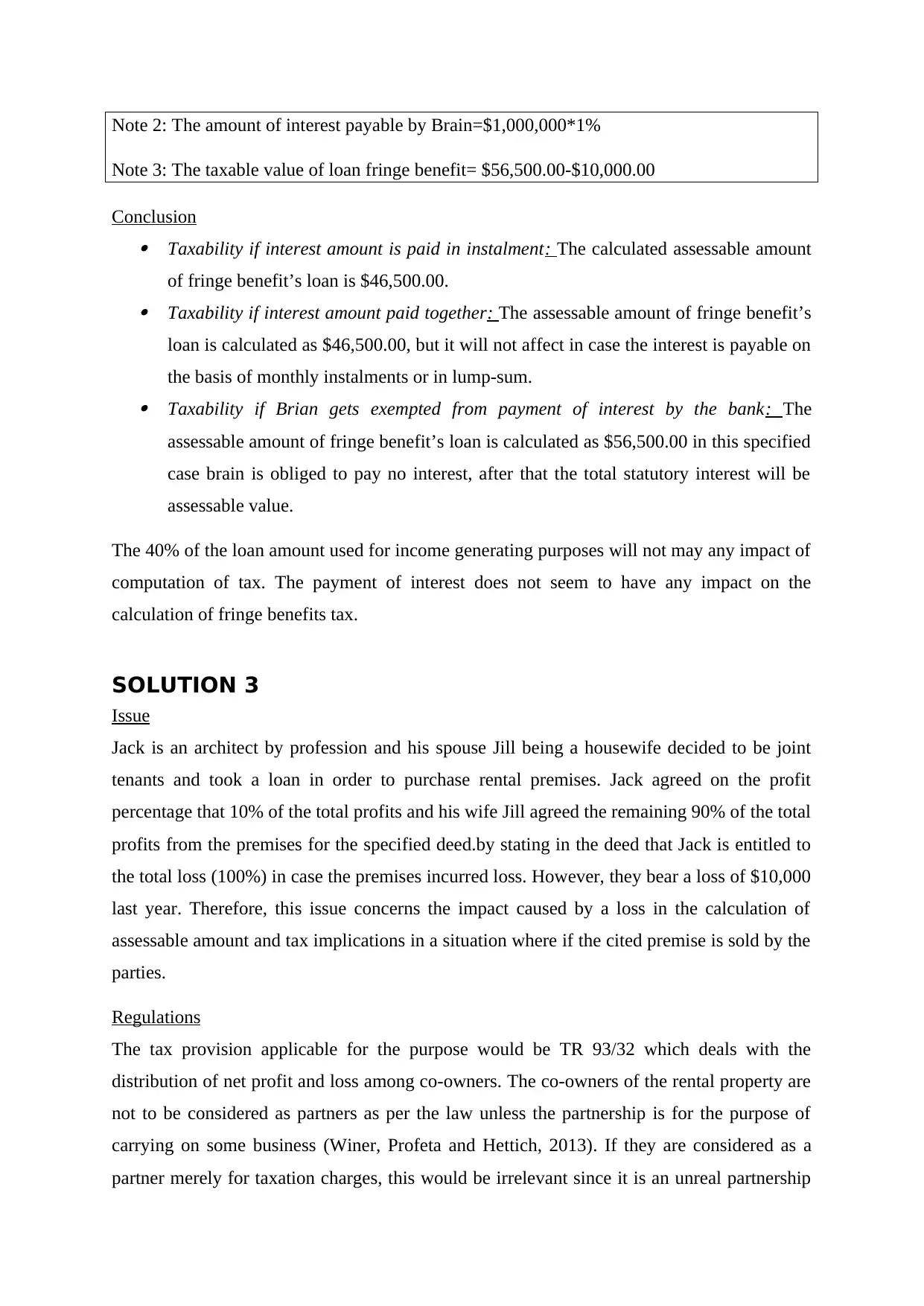
Note 2: The amount of interest payable by Brain=$1,000,000*1%
Note 3: The taxable value of loan fringe benefit= $56,500.00-$10,000.00
Conclusion Taxability if interest amount is paid in instalment: The calculated assessable amount
of fringe benefit’s loan is $46,500.00. Taxability if interest amount paid together: The assessable amount of fringe benefit’s
loan is calculated as $46,500.00, but it will not affect in case the interest is payable on
the basis of monthly instalments or in lump-sum. Taxability if Brian gets exempted from payment of interest by the bank: The
assessable amount of fringe benefit’s loan is calculated as $56,500.00 in this specified
case brain is obliged to pay no interest, after that the total statutory interest will be
assessable value.
The 40% of the loan amount used for income generating purposes will not may any impact of
computation of tax. The payment of interest does not seem to have any impact on the
calculation of fringe benefits tax.
SOLUTION 3
Issue
Jack is an architect by profession and his spouse Jill being a housewife decided to be joint
tenants and took a loan in order to purchase rental premises. Jack agreed on the profit
percentage that 10% of the total profits and his wife Jill agreed the remaining 90% of the total
profits from the premises for the specified deed.by stating in the deed that Jack is entitled to
the total loss (100%) in case the premises incurred loss. However, they bear a loss of $10,000
last year. Therefore, this issue concerns the impact caused by a loss in the calculation of
assessable amount and tax implications in a situation where if the cited premise is sold by the
parties.
Regulations
The tax provision applicable for the purpose would be TR 93/32 which deals with the
distribution of net profit and loss among co-owners. The co-owners of the rental property are
not to be considered as partners as per the law unless the partnership is for the purpose of
carrying on some business (Winer, Profeta and Hettich, 2013). If they are considered as a
partner merely for taxation charges, this would be irrelevant since it is an unreal partnership
Note 3: The taxable value of loan fringe benefit= $56,500.00-$10,000.00
Conclusion Taxability if interest amount is paid in instalment: The calculated assessable amount
of fringe benefit’s loan is $46,500.00. Taxability if interest amount paid together: The assessable amount of fringe benefit’s
loan is calculated as $46,500.00, but it will not affect in case the interest is payable on
the basis of monthly instalments or in lump-sum. Taxability if Brian gets exempted from payment of interest by the bank: The
assessable amount of fringe benefit’s loan is calculated as $56,500.00 in this specified
case brain is obliged to pay no interest, after that the total statutory interest will be
assessable value.
The 40% of the loan amount used for income generating purposes will not may any impact of
computation of tax. The payment of interest does not seem to have any impact on the
calculation of fringe benefits tax.
SOLUTION 3
Issue
Jack is an architect by profession and his spouse Jill being a housewife decided to be joint
tenants and took a loan in order to purchase rental premises. Jack agreed on the profit
percentage that 10% of the total profits and his wife Jill agreed the remaining 90% of the total
profits from the premises for the specified deed.by stating in the deed that Jack is entitled to
the total loss (100%) in case the premises incurred loss. However, they bear a loss of $10,000
last year. Therefore, this issue concerns the impact caused by a loss in the calculation of
assessable amount and tax implications in a situation where if the cited premise is sold by the
parties.
Regulations
The tax provision applicable for the purpose would be TR 93/32 which deals with the
distribution of net profit and loss among co-owners. The co-owners of the rental property are
not to be considered as partners as per the law unless the partnership is for the purpose of
carrying on some business (Winer, Profeta and Hettich, 2013). If they are considered as a
partner merely for taxation charges, this would be irrelevant since it is an unreal partnership
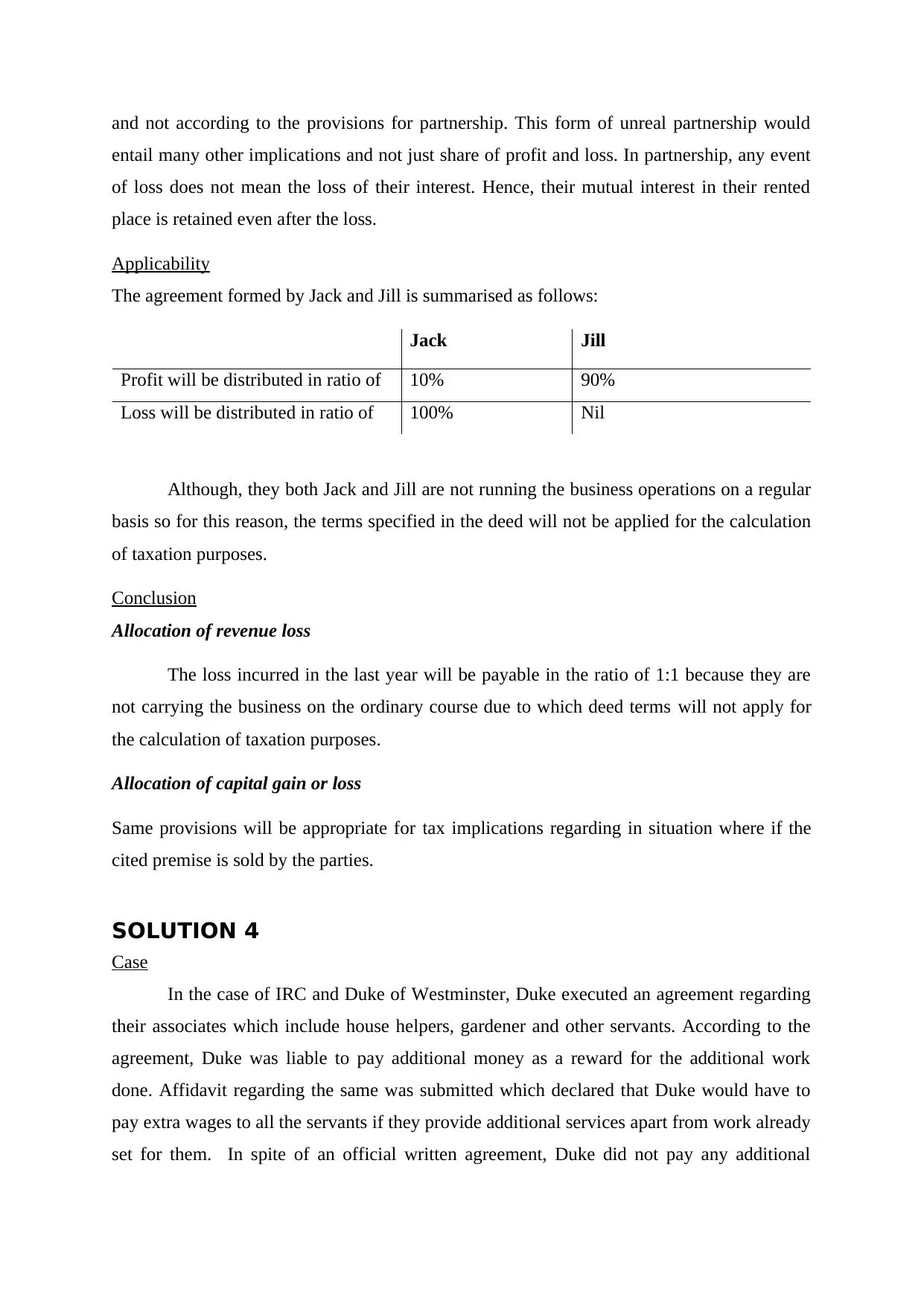
and not according to the provisions for partnership. This form of unreal partnership would
entail many other implications and not just share of profit and loss. In partnership, any event
of loss does not mean the loss of their interest. Hence, their mutual interest in their rented
place is retained even after the loss.
Applicability
The agreement formed by Jack and Jill is summarised as follows:
Jack Jill
Profit will be distributed in ratio of 10% 90%
Loss will be distributed in ratio of 100% Nil
Although, they both Jack and Jill are not running the business operations on a regular
basis so for this reason, the terms specified in the deed will not be applied for the calculation
of taxation purposes.
Conclusion
Allocation of revenue loss
The loss incurred in the last year will be payable in the ratio of 1:1 because they are
not carrying the business on the ordinary course due to which deed terms will not apply for
the calculation of taxation purposes.
Allocation of capital gain or loss
Same provisions will be appropriate for tax implications regarding in situation where if the
cited premise is sold by the parties.
SOLUTION 4
Case
In the case of IRC and Duke of Westminster, Duke executed an agreement regarding
their associates which include house helpers, gardener and other servants. According to the
agreement, Duke was liable to pay additional money as a reward for the additional work
done. Affidavit regarding the same was submitted which declared that Duke would have to
pay extra wages to all the servants if they provide additional services apart from work already
set for them. In spite of an official written agreement, Duke did not pay any additional
entail many other implications and not just share of profit and loss. In partnership, any event
of loss does not mean the loss of their interest. Hence, their mutual interest in their rented
place is retained even after the loss.
Applicability
The agreement formed by Jack and Jill is summarised as follows:
Jack Jill
Profit will be distributed in ratio of 10% 90%
Loss will be distributed in ratio of 100% Nil
Although, they both Jack and Jill are not running the business operations on a regular
basis so for this reason, the terms specified in the deed will not be applied for the calculation
of taxation purposes.
Conclusion
Allocation of revenue loss
The loss incurred in the last year will be payable in the ratio of 1:1 because they are
not carrying the business on the ordinary course due to which deed terms will not apply for
the calculation of taxation purposes.
Allocation of capital gain or loss
Same provisions will be appropriate for tax implications regarding in situation where if the
cited premise is sold by the parties.
SOLUTION 4
Case
In the case of IRC and Duke of Westminster, Duke executed an agreement regarding
their associates which include house helpers, gardener and other servants. According to the
agreement, Duke was liable to pay additional money as a reward for the additional work
done. Affidavit regarding the same was submitted which declared that Duke would have to
pay extra wages to all the servants if they provide additional services apart from work already
set for them. In spite of an official written agreement, Duke did not pay any additional
⊘ This is a preview!⊘
Do you want full access?
Subscribe today to unlock all pages.

Trusted by 1+ million students worldwide
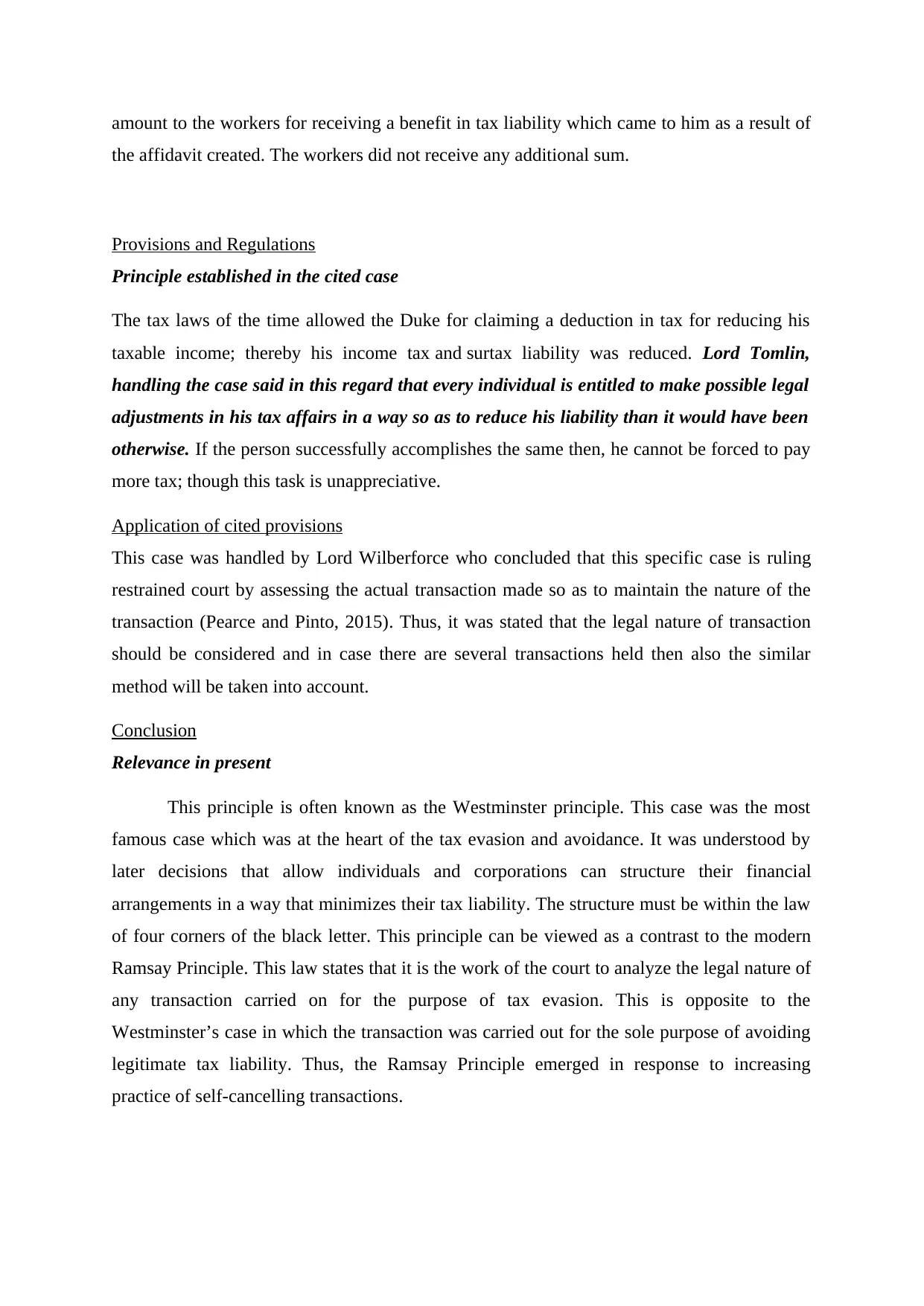
amount to the workers for receiving a benefit in tax liability which came to him as a result of
the affidavit created. The workers did not receive any additional sum.
Provisions and Regulations
Principle established in the cited case
The tax laws of the time allowed the Duke for claiming a deduction in tax for reducing his
taxable income; thereby his income tax and surtax liability was reduced. Lord Tomlin,
handling the case said in this regard that every individual is entitled to make possible legal
adjustments in his tax affairs in a way so as to reduce his liability than it would have been
otherwise. If the person successfully accomplishes the same then, he cannot be forced to pay
more tax; though this task is unappreciative.
Application of cited provisions
This case was handled by Lord Wilberforce who concluded that this specific case is ruling
restrained court by assessing the actual transaction made so as to maintain the nature of the
transaction (Pearce and Pinto, 2015). Thus, it was stated that the legal nature of transaction
should be considered and in case there are several transactions held then also the similar
method will be taken into account.
Conclusion
Relevance in present
This principle is often known as the Westminster principle. This case was the most
famous case which was at the heart of the tax evasion and avoidance. It was understood by
later decisions that allow individuals and corporations can structure their financial
arrangements in a way that minimizes their tax liability. The structure must be within the law
of four corners of the black letter. This principle can be viewed as a contrast to the modern
Ramsay Principle. This law states that it is the work of the court to analyze the legal nature of
any transaction carried on for the purpose of tax evasion. This is opposite to the
Westminster’s case in which the transaction was carried out for the sole purpose of avoiding
legitimate tax liability. Thus, the Ramsay Principle emerged in response to increasing
practice of self-cancelling transactions.
the affidavit created. The workers did not receive any additional sum.
Provisions and Regulations
Principle established in the cited case
The tax laws of the time allowed the Duke for claiming a deduction in tax for reducing his
taxable income; thereby his income tax and surtax liability was reduced. Lord Tomlin,
handling the case said in this regard that every individual is entitled to make possible legal
adjustments in his tax affairs in a way so as to reduce his liability than it would have been
otherwise. If the person successfully accomplishes the same then, he cannot be forced to pay
more tax; though this task is unappreciative.
Application of cited provisions
This case was handled by Lord Wilberforce who concluded that this specific case is ruling
restrained court by assessing the actual transaction made so as to maintain the nature of the
transaction (Pearce and Pinto, 2015). Thus, it was stated that the legal nature of transaction
should be considered and in case there are several transactions held then also the similar
method will be taken into account.
Conclusion
Relevance in present
This principle is often known as the Westminster principle. This case was the most
famous case which was at the heart of the tax evasion and avoidance. It was understood by
later decisions that allow individuals and corporations can structure their financial
arrangements in a way that minimizes their tax liability. The structure must be within the law
of four corners of the black letter. This principle can be viewed as a contrast to the modern
Ramsay Principle. This law states that it is the work of the court to analyze the legal nature of
any transaction carried on for the purpose of tax evasion. This is opposite to the
Westminster’s case in which the transaction was carried out for the sole purpose of avoiding
legitimate tax liability. Thus, the Ramsay Principle emerged in response to increasing
practice of self-cancelling transactions.
Paraphrase This Document
Need a fresh take? Get an instant paraphrase of this document with our AI Paraphraser
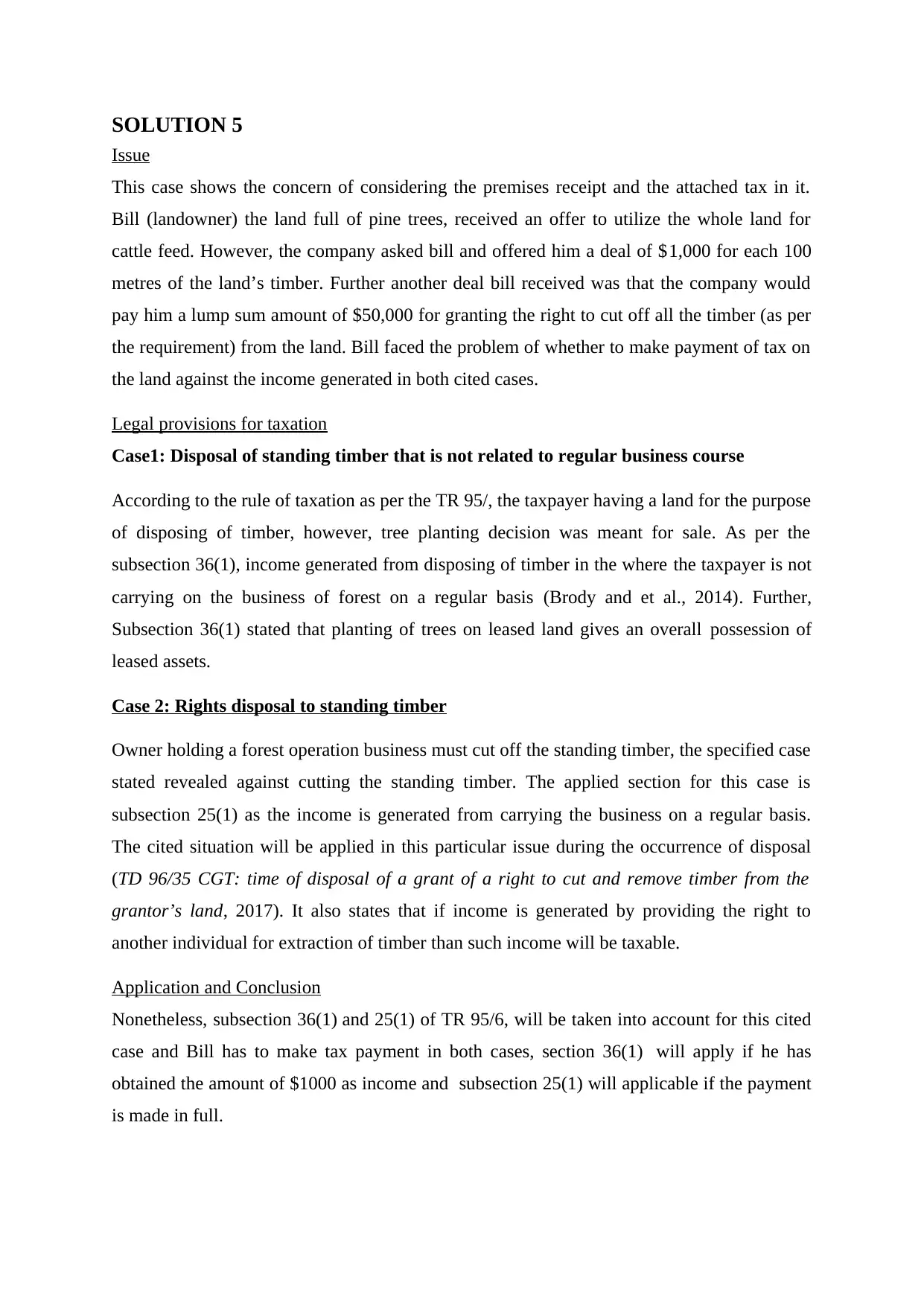
SOLUTION 5
Issue
This case shows the concern of considering the premises receipt and the attached tax in it.
Bill (landowner) the land full of pine trees, received an offer to utilize the whole land for
cattle feed. However, the company asked bill and offered him a deal of $1,000 for each 100
metres of the land’s timber. Further another deal bill received was that the company would
pay him a lump sum amount of $50,000 for granting the right to cut off all the timber (as per
the requirement) from the land. Bill faced the problem of whether to make payment of tax on
the land against the income generated in both cited cases.
Legal provisions for taxation
Case1: Disposal of standing timber that is not related to regular business course
According to the rule of taxation as per the TR 95/, the taxpayer having a land for the purpose
of disposing of timber, however, tree planting decision was meant for sale. As per the
subsection 36(1), income generated from disposing of timber in the where the taxpayer is not
carrying on the business of forest on a regular basis (Brody and et al., 2014). Further,
Subsection 36(1) stated that planting of trees on leased land gives an overall possession of
leased assets.
Case 2: Rights disposal to standing timber
Owner holding a forest operation business must cut off the standing timber, the specified case
stated revealed against cutting the standing timber. The applied section for this case is
subsection 25(1) as the income is generated from carrying the business on a regular basis.
The cited situation will be applied in this particular issue during the occurrence of disposal
(TD 96/35 CGT: time of disposal of a grant of a right to cut and remove timber from the
grantor’s land, 2017). It also states that if income is generated by providing the right to
another individual for extraction of timber than such income will be taxable.
Application and Conclusion
Nonetheless, subsection 36(1) and 25(1) of TR 95/6, will be taken into account for this cited
case and Bill has to make tax payment in both cases, section 36(1) will apply if he has
obtained the amount of $1000 as income and subsection 25(1) will applicable if the payment
is made in full.
Issue
This case shows the concern of considering the premises receipt and the attached tax in it.
Bill (landowner) the land full of pine trees, received an offer to utilize the whole land for
cattle feed. However, the company asked bill and offered him a deal of $1,000 for each 100
metres of the land’s timber. Further another deal bill received was that the company would
pay him a lump sum amount of $50,000 for granting the right to cut off all the timber (as per
the requirement) from the land. Bill faced the problem of whether to make payment of tax on
the land against the income generated in both cited cases.
Legal provisions for taxation
Case1: Disposal of standing timber that is not related to regular business course
According to the rule of taxation as per the TR 95/, the taxpayer having a land for the purpose
of disposing of timber, however, tree planting decision was meant for sale. As per the
subsection 36(1), income generated from disposing of timber in the where the taxpayer is not
carrying on the business of forest on a regular basis (Brody and et al., 2014). Further,
Subsection 36(1) stated that planting of trees on leased land gives an overall possession of
leased assets.
Case 2: Rights disposal to standing timber
Owner holding a forest operation business must cut off the standing timber, the specified case
stated revealed against cutting the standing timber. The applied section for this case is
subsection 25(1) as the income is generated from carrying the business on a regular basis.
The cited situation will be applied in this particular issue during the occurrence of disposal
(TD 96/35 CGT: time of disposal of a grant of a right to cut and remove timber from the
grantor’s land, 2017). It also states that if income is generated by providing the right to
another individual for extraction of timber than such income will be taxable.
Application and Conclusion
Nonetheless, subsection 36(1) and 25(1) of TR 95/6, will be taken into account for this cited
case and Bill has to make tax payment in both cases, section 36(1) will apply if he has
obtained the amount of $1000 as income and subsection 25(1) will applicable if the payment
is made in full.
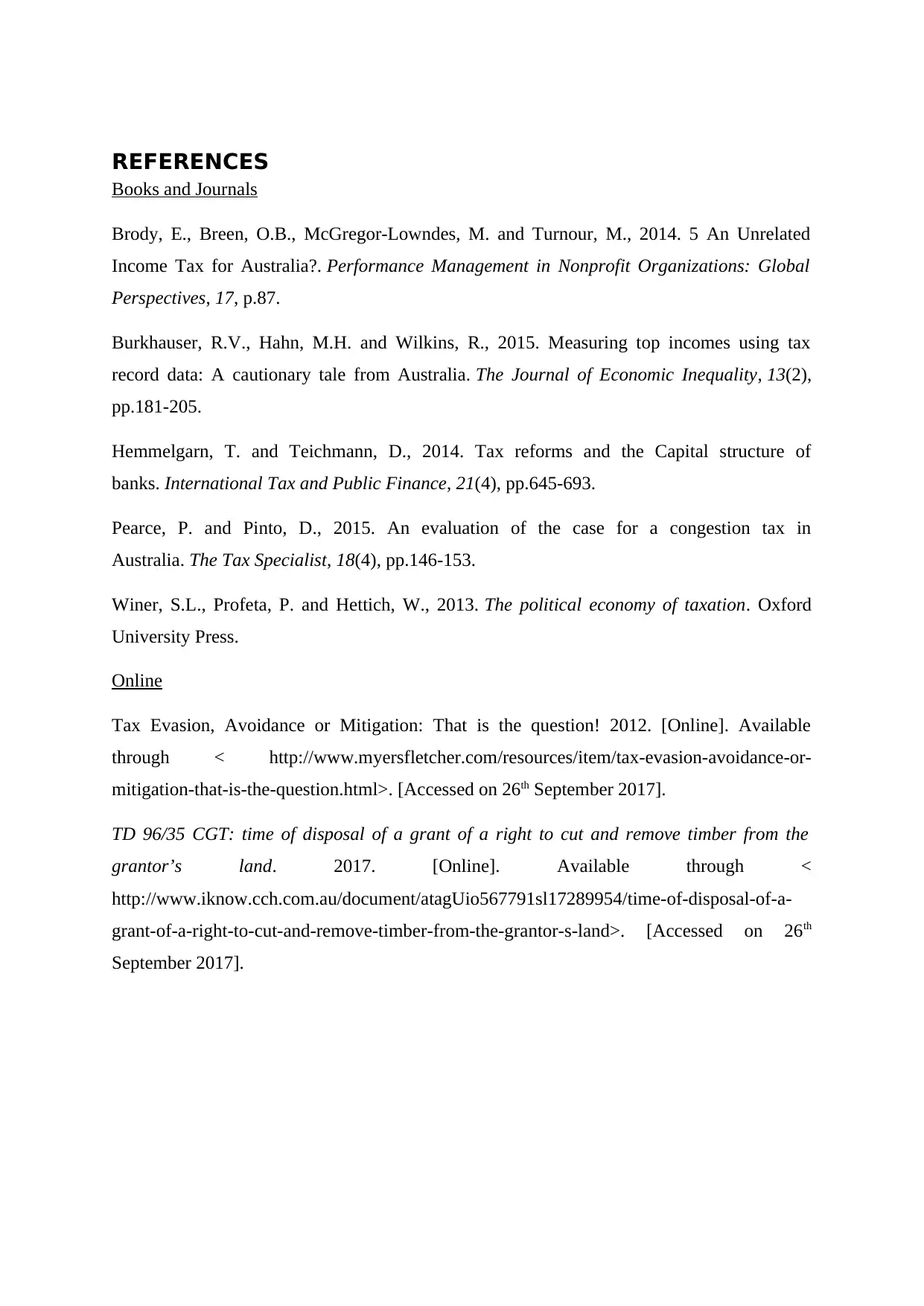
REFERENCES
Books and Journals
Brody, E., Breen, O.B., McGregor-Lowndes, M. and Turnour, M., 2014. 5 An Unrelated
Income Tax for Australia?. Performance Management in Nonprofit Organizations: Global
Perspectives, 17, p.87.
Burkhauser, R.V., Hahn, M.H. and Wilkins, R., 2015. Measuring top incomes using tax
record data: A cautionary tale from Australia. The Journal of Economic Inequality, 13(2),
pp.181-205.
Hemmelgarn, T. and Teichmann, D., 2014. Tax reforms and the Capital structure of
banks. International Tax and Public Finance, 21(4), pp.645-693.
Pearce, P. and Pinto, D., 2015. An evaluation of the case for a congestion tax in
Australia. The Tax Specialist, 18(4), pp.146-153.
Winer, S.L., Profeta, P. and Hettich, W., 2013. The political economy of taxation. Oxford
University Press.
Online
Tax Evasion, Avoidance or Mitigation: That is the question! 2012. [Online]. Available
through < http://www.myersfletcher.com/resources/item/tax-evasion-avoidance-or-
mitigation-that-is-the-question.html>. [Accessed on 26th September 2017].
TD 96/35 CGT: time of disposal of a grant of a right to cut and remove timber from the
grantor’s land. 2017. [Online]. Available through <
http://www.iknow.cch.com.au/document/atagUio567791sl17289954/time-of-disposal-of-a-
grant-of-a-right-to-cut-and-remove-timber-from-the-grantor-s-land>. [Accessed on 26th
September 2017].
Books and Journals
Brody, E., Breen, O.B., McGregor-Lowndes, M. and Turnour, M., 2014. 5 An Unrelated
Income Tax for Australia?. Performance Management in Nonprofit Organizations: Global
Perspectives, 17, p.87.
Burkhauser, R.V., Hahn, M.H. and Wilkins, R., 2015. Measuring top incomes using tax
record data: A cautionary tale from Australia. The Journal of Economic Inequality, 13(2),
pp.181-205.
Hemmelgarn, T. and Teichmann, D., 2014. Tax reforms and the Capital structure of
banks. International Tax and Public Finance, 21(4), pp.645-693.
Pearce, P. and Pinto, D., 2015. An evaluation of the case for a congestion tax in
Australia. The Tax Specialist, 18(4), pp.146-153.
Winer, S.L., Profeta, P. and Hettich, W., 2013. The political economy of taxation. Oxford
University Press.
Online
Tax Evasion, Avoidance or Mitigation: That is the question! 2012. [Online]. Available
through < http://www.myersfletcher.com/resources/item/tax-evasion-avoidance-or-
mitigation-that-is-the-question.html>. [Accessed on 26th September 2017].
TD 96/35 CGT: time of disposal of a grant of a right to cut and remove timber from the
grantor’s land. 2017. [Online]. Available through <
http://www.iknow.cch.com.au/document/atagUio567791sl17289954/time-of-disposal-of-a-
grant-of-a-right-to-cut-and-remove-timber-from-the-grantor-s-land>. [Accessed on 26th
September 2017].
⊘ This is a preview!⊘
Do you want full access?
Subscribe today to unlock all pages.

Trusted by 1+ million students worldwide
1 out of 9
Related Documents
Your All-in-One AI-Powered Toolkit for Academic Success.
+13062052269
info@desklib.com
Available 24*7 on WhatsApp / Email
![[object Object]](/_next/static/media/star-bottom.7253800d.svg)
Unlock your academic potential
Copyright © 2020–2025 A2Z Services. All Rights Reserved. Developed and managed by ZUCOL.





